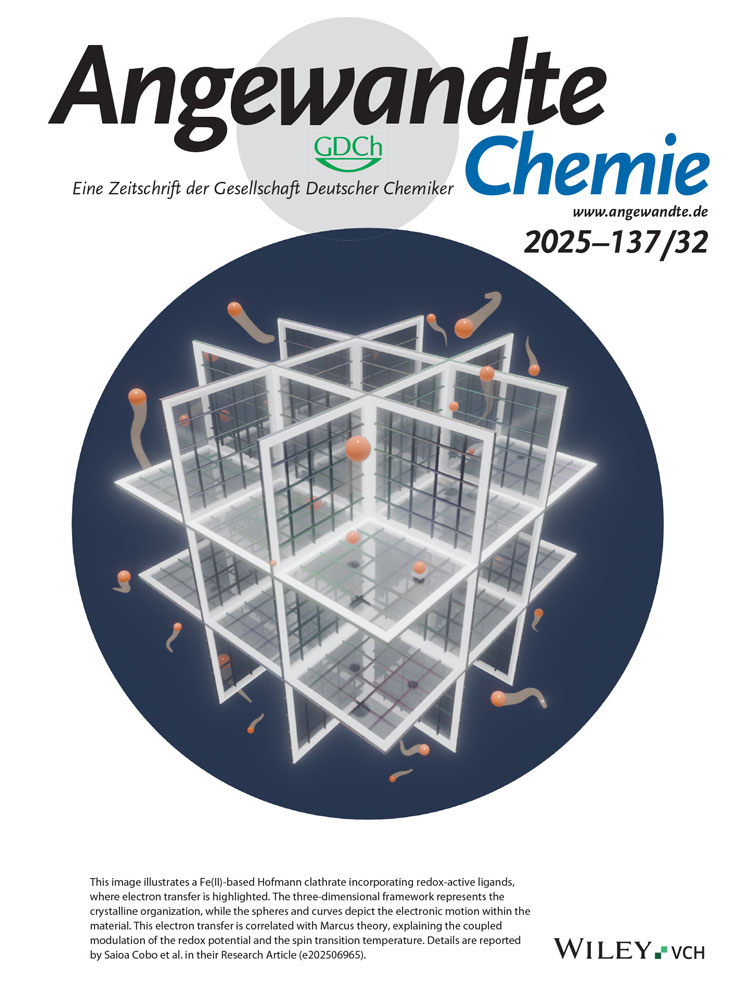Poly(phenylensulfidphenylenamin) (PPSA) – die „Verbindung”︁ von Polyphenylensulfid mit Polyanilin
Dr. Lixiang Wang
Max-Planck-Institut für Polymerforschung Postfach 31 48, D–55021 Mainz Telefax: Int. +6131/379–100
Search for more papers by this authorThomas Soczka-Guth Dipl.-Chem.
Max-Planck-Institut für Polymerforschung Postfach 31 48, D–55021 Mainz Telefax: Int. +6131/379–100
Search for more papers by this authorDr. Edsko Havinga
Philips Research Laboratories Prof. Hostlaan 4, NL–5600 AA Eindhoven (Niederlande)
Search for more papers by this authorCorresponding Author
Prof. Dr. Klaus Müllen
Max-Planck-Institut für Polymerforschung Postfach 31 48, D–55021 Mainz Telefax: Int. +6131/379–100
Max-Planck-Institut für Polymerforschung Postfach 31 48, D–55021 Mainz Telefax: Int. +6131/379–100Search for more papers by this authorDr. Lixiang Wang
Max-Planck-Institut für Polymerforschung Postfach 31 48, D–55021 Mainz Telefax: Int. +6131/379–100
Search for more papers by this authorThomas Soczka-Guth Dipl.-Chem.
Max-Planck-Institut für Polymerforschung Postfach 31 48, D–55021 Mainz Telefax: Int. +6131/379–100
Search for more papers by this authorDr. Edsko Havinga
Philips Research Laboratories Prof. Hostlaan 4, NL–5600 AA Eindhoven (Niederlande)
Search for more papers by this authorCorresponding Author
Prof. Dr. Klaus Müllen
Max-Planck-Institut für Polymerforschung Postfach 31 48, D–55021 Mainz Telefax: Int. +6131/379–100
Max-Planck-Institut für Polymerforschung Postfach 31 48, D–55021 Mainz Telefax: Int. +6131/379–100Search for more papers by this authorAbstract
Zwei Strukturen, ein Polymer. Die beiden wichtigen Materialien Polyanilin und Polyphenylensulfid sind in Poly(phenylensulfidphenylenamin) (PPSA) 1 zu einer Verbindung vereinigt. Über ein Polysulfoniumkation als Synthesevorstufe kann das lösliche Polymer 1 mit perfekter Struktur und hohen Molekulargewichten erhalten werden.
References
- 1
L. Freund,
W. Heitz,
Makromol. Chem.
1990,
191,
815;
W. Heitz,
M. Peter
( Bayer AG),
DE-A 4311139 A1 941006,
1993;
H. W. Hill
in
High Performance Polymers: Their Origin and Development
(Hrsg.: R. B. Seymour,
G. S. Kirschbaum),
Elsevier, New York,
1986,
S. 135–148;
10.1007/978-94-011-7073-4_14 Google ScholarJ. T. Edmonds, H. W. Hill (Philips Petroleum Co.), USA 3354 129, 1967.
- 2 A. G. MacDiarmid, A. J. Epstein in Conjugated Polymeric Materials (Hrsg.: J. L. Brédas, R. R. Chance), Kluwer, Boston, 1990, S. 53; F. Lux, Polymer 1994, 14, 2915.
- 3 T. Migita, T. Shimizu, Y. Asami, J. Shiobara, Y. Kato, M. Kosugi, Bull. Chem. Soc. Jpn. 1980, 53, 1385; J. Lindley, Tetrahedron 1984, 40, 1439; T. Fujisawa, M. Kakutani, Polym. Lett. 1970, 8, 511.
- 4 E. Shouji, S. Nishimura, K. Yamamoto, E. Tsuchida, Chem. Lett. 1994, 403; K. Yamamoto, E. Shouji, H. Nishide, E. Tsuchida, J. Am. Chem. Soc. 1993, 115, 5819; T. Fujisawa, M. Kakutani, N. Kobayashi, Polym. Lett. 1973, 11, 725.
- 5 T. Ho, Synthesis 1973, 2, 347.
- 6 9: Toluidin, 4-Brom-methylsulfoxybenzol, Kaliumcarbonat, Kupfer(I)-iodid, 1,3-Dimethyltetrahydro-2(1H)-pyrimidinon, 190°C. 18 Stunden, Ausbeute 35–45%.
- 7 A. Gattermann, Justus Liebigs Ann. Chem. 1913, 393, 232.
- 8 13: 1H-NMR (200 MHz, [D6]DMSO): 9.58 (s, 1H, NH), 7.95 und 7.41 (d, 4H, J(H,H) = 8.7 Hz), 3.70 (s, 3H, S+ -CH3);13C-NMR (50 MHz, [D6]DMSO): 146.6. 131.8, 118.7, 117.4, 117.4. 24.0.
- 9 1: 1H-NMR (200 MHz, [D6MSO]): 8.41 (s. 1H, NH), 7.03 und 7.21 (d, 4H, J(H,H) = 9.2 Hz).
- 10 Säule: SDV-Gel-10-äm-Partikel (103, 105. 106 Å), PS-Eichung. THF.
- 11 Abimed-MO-1, Membran-UF-C-10 (RC). DMF.
- 12
G. Cauquis,
H. Delhomme,
D. Serve,
Tetrahedron Lett.
1971,
44,
4113.
10.1016/S0040-4039(01)97475-1 Google Scholar
- 13 R. Bilger, J. Heintze, Synth. Met. 1991, 41–43, 2893.
- 14 Vierpunktmessung mit linearer Probengeometrie, Gleichstrom.
- 15 J. E. Frommer, R. L. Elsenbaum, R. R. Chance, ACS Symp. Ser. 1984, 242, 447.
- 16 A. G. MacDiarmid in Conjugated Polymers and Related Materials (Hrsg.: W. R. Salaneck, I. Lundström, B. Ranby), Oxford University Press. Oxford, 1993, S. 73, zit. Lit.
- 17 C. M. Mikulski, P. J. Russo, M. S. Saran, A. D. MacDiarmid, A. F. Garito, A. J. Heeger, J. Am. Chem. Soc. 1975, 97, 6358.
- 18 L. Grossi, J. Chem. Soc. Chem. Commun. 1989, 1248; F. Neugebauer, S. Bamberger, Chem. Ber. 1974, 107, 2363.
- 19 Geometrieoptimierung nach dem AM-1-Verfahren: J. J. P. Stewart, J. Am. Chem. Soc. 1985, 107, 3902.
Citing Literature
This is the
German version
of Angewandte Chemie.
Note for articles published since 1962:
Do not cite this version alone.
Take me to the International Edition version with citable page numbers, DOI, and citation export.
We apologize for the inconvenience.





